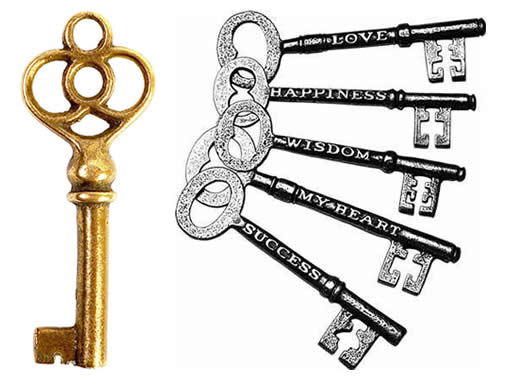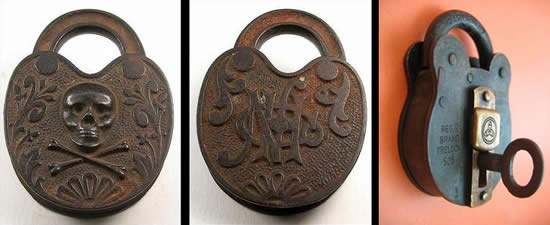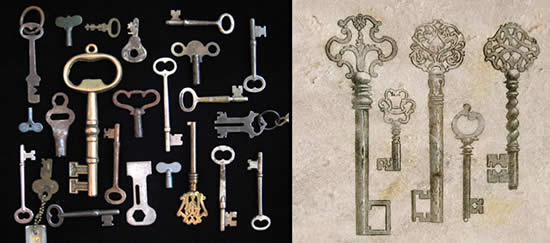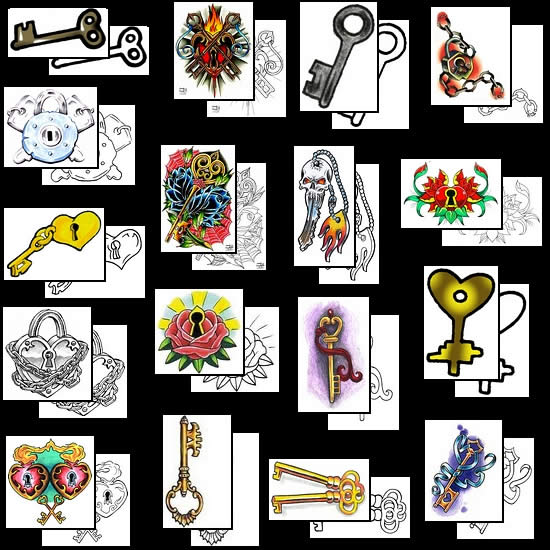|
|
|||
 |
|||
|
TATTOO DESIGNS & SYMBOLS - KEY & LOCK TATTOOS
Tattoo Symbol Index - A B C D E F G H I J K L M N O P Q R S T U V W X Y Z Tattoo designs - K >> Keys & Locks
Keys represent the forces which open and close, bind and release, and mark the arrival at a new phase or status in life, such as reaching adulthood at 21 years of age, or 'getting the keys to the car' when an individual turns sixteen and can legally drive a car. The ancient Egyptian 'ankh' - a key-shaped cross - symbolized transition from this life to the next. For a new home owner, the handing over of the keys to the house is far more symbolic of taking ownership than the signing of any legal documents. The possessor of the keys to the castle, is indeed King in his own home. The lock and key played a significant part in folklore and fairy stories and were symbols of magic and power. Keys lost and found were a favourite theme. The key has also become a symbol of surrender. A lock or a key can stand for both liberation and imprisonment. When a vanquished king or nobleman handed over the keys of the city to the conqueror, it acknowledged his defeat. The famous French Bayeux Tapestry depicts the defeated Duke Conan giving the keys of his city to William, Duke of Normandy, otherwise known as William the Conqueror. In turn, one of greatest honours that can bestowed upon an individual is to be given the 'Key to the City', and declared a free man of that community, to come and go as one pleases, unrestricted and with total freedom.
Prior to lock and key technology, people stashed their valuables in hollow trees, rivers or caverns, protected by boulders or brambles, or else they buried them in the earth. Doors and gates were secured with ropes and cords. The earliest security mechanisms resembling keys and locks appeared in ancient Egypt and China more than 4,000 years ago. Similar wooden devices have been found in Scandinavia, parts of Africa, and the Balkan states. Some keys were said to be 2 feet long, and the lock 'as much as a man could carry'. The keyhole was said to have been invented by the ancient Greeks. One of the most frequent uses of the first locks was to safeguard temple gates. In Greek mythology, Homer describes the storeroom of Ulysses being 'bolted', and his wife Penelope with a key of 'copper with an ivory handle'. When the Romans introduced metal locking devices, they were made of iron, the keys of bronze. Some keys were small enough to be worn as rings on the fingers. The Romans were also believed to have invented the padlock, although similar locking devices appeared simultaneously in China and Mesopotamia. The lock's design or a key's embellishment reflected its origin, popular motifs being dragons, dogs, and horses. Metal locks from early Roman times have been excavated in Britain, and can still be found in use in Norway. In the Viking era, women not only had equal status as men but became the 'key bearer' when they married. The key was worn outside the clothing as a symbol of pride and status. Likewise in China, married women were called 'key carriers'. Reference to keys and locks appears in the Old Testament story of the old gate of Jerusalem being repaired with 'locks, keys and bars'. It has been said by some modern inventors of keys that the most exquisite workmanship in lock-making was during the medieval era. Lock plates and key heads appeared with elaborate gothic mouldings and embellishment, and the precision mechanisms were close to perfection. Still, even the best and most beautiful were not so fool-proof that a good thief couldn't pick it. During the reign of England's Elizabeth I, the locksmith had become a valued trade, and more efficient and secure mechanisms began to appear.
In popular literature and other media, in particular that of the fantasy genre, the character of the "Key Master" is a well-known one. Whether in a novel, a comic, a movie or a video game, the protagonist must undertake a hazardous journey filled with many dangers to find the Key Master and gain access to the key that will unlock great knowledge, magic or special power, or an item that is often described in myth and legend as being one of a kind.
Get inspired by some really amazing images and photos in our Key & Lock, Padlock Inspiration Gallery See also: Love Tattoo Index Choose your tattoo from many different key, lock and padlock tattoo design ideas by the world's top tattoo artists and flash illustrators at Tattoo Johnny. Tattoo designs - K >> Keys & Locks Tattoo Symbol Index - A B C D E F G H I J K L M N O P Q R S T U V W X Y Z |
||
Tattoo Designs provided by TattooJohnny.com |
|||
| Celeb Tattoos | Facts & Stats | Designs & Symbols | History | Culture | Links | Tattoo Galleries | Contact | |||
|
|
|||



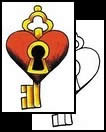 Key
& Lock, Padlock Tattoos - Keys, and the locks or
padlocks they fit, are fascinating symbols, and have often been
featured in many different genres of tattoo designs. Since the
earliest times, great steps have been taken to secure personal
property, be it material, familial, or spiritual. To protect a
treasure chest filled with gold or a heart just as pure, humans have
found ways to keep looters at bay. Locks and keys speak of the value
of what is locked away, and imply 'restricted access'. Neither was
heaven accessible without the prescribed 'keys to the kingdom', of
which Christ made Peter the guardian.
Key
& Lock, Padlock Tattoos - Keys, and the locks or
padlocks they fit, are fascinating symbols, and have often been
featured in many different genres of tattoo designs. Since the
earliest times, great steps have been taken to secure personal
property, be it material, familial, or spiritual. To protect a
treasure chest filled with gold or a heart just as pure, humans have
found ways to keep looters at bay. Locks and keys speak of the value
of what is locked away, and imply 'restricted access'. Neither was
heaven accessible without the prescribed 'keys to the kingdom', of
which Christ made Peter the guardian.